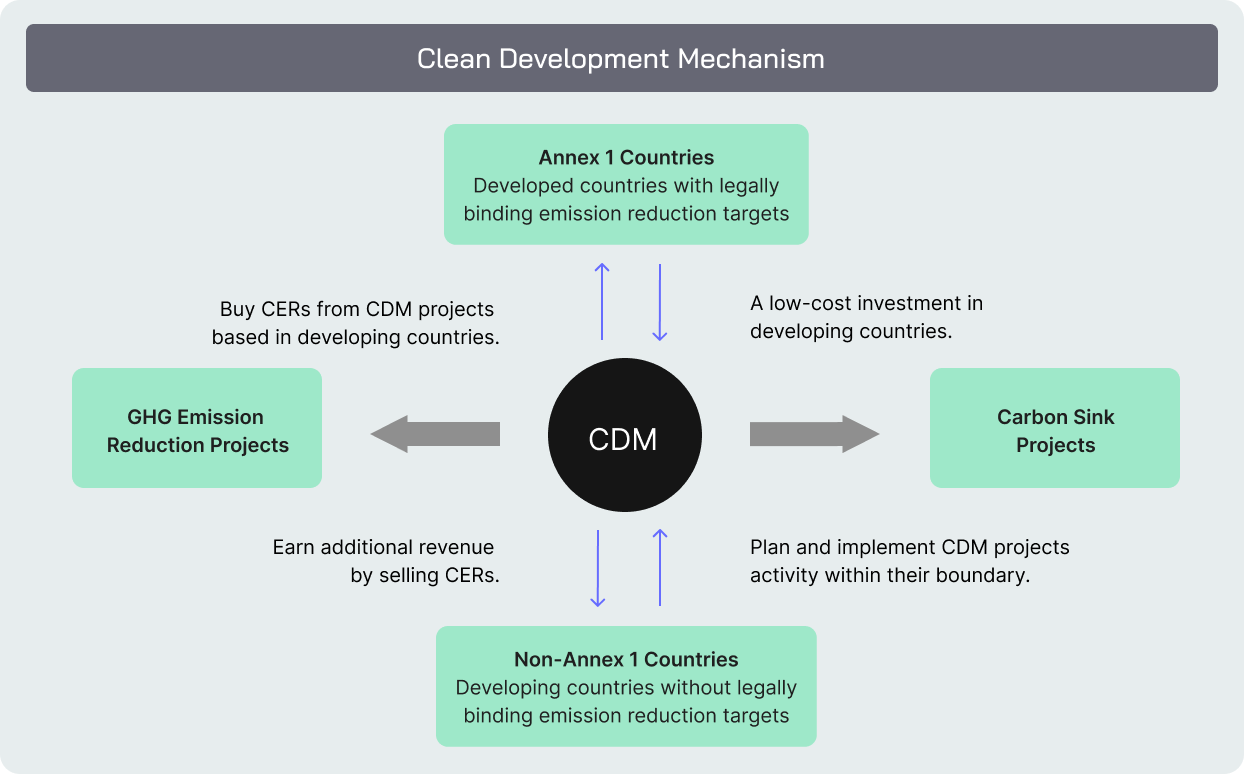Clean Development Mechanism (CDM): Climate protection as a global learning process

Über 8.000 registrierte Projekte weltweit und Milliarden an eingesparten Emissionen sprechen für das Potenzial dieses Mechanismus, doch auch die Kritik ist nicht verstummt. Was können wir heute aus dem CDM lernen, und welche Rolle spielt er im Kontext neuerer Ansätze wie Artikel 6 des Pariser Abkommens?
What is the Clean Development Mechanism?
The Clean Development Mechanism (CDM) was established in 1997 as part of the Kyoto Protocol and is one of three flexible mechanisms for international cooperation in climate protection, alongside Emissions Trading and Joint Implementation.
Two main objectives of the CDM:
- Reducing climate protection costs:
- Industrialized countries could obtain emission certificates (CERs) at relatively low cost by financing projects in developing countries. These certificates were then credited toward their own reduction targets.
- Promoting sustainable development:
- The projects were intended not only to reduce greenhouse gas emissions but also to support social and economic development in host countries.
Typical CDM projects include:
- Expansion of renewable energy (e.g., wind or hydropower plants)
- Energy efficiency improvements in industry or buildings
- Methane capture or avoidance from landfills
Further information is available on the official UNFCCC CDM website.

How does the CDM work?
The CDM follows a standardized project cycle designed to ensure additional and measurable emission reductions:
- Project Definition: Climate protection projects are described in a Project Design Document (PDD).
- Validation: An independent auditing body (Designated Operational Entity - DOE, e.g., TÜV Süd) evaluates the project.
- Registration: After successful validation, the project is officially registered by the CDM Executive Board.
- Monitoring & Verification: The achieved emission reductions are monitored and verified again by a DOE.
- Certification: The Executive Board issues Certified Emission Reductions (CERs) based on the verified reductions.
Facts, Figures & Criticism of the CDM
For many years, the Clean Development Mechanism was the largest international climate protection instrument of its kind.
- Between 2004 and 2012, over 8,000 projects were registered in more than 100 countries (UNFCCC).
- By 2020, more than 2 billion CERs had been issued (German Environment Agency).
- China, India, and Brazil were among the largest host countries.
- Most projects were in the energy sector, e.g., wind power, hydropower, or landfill gas.
Despite its scale, the CDM’s actual climate impact remained controversial:
- Many projects would likely have been implemented even without CDM incentives, such as large hydropower or industrial gas projects. This led to the issuance of emission credits without real emission reductions.
- Due to an oversupply of CERs and insufficient demand, prices collapsed dramatically—from over €20 (2008) to below €0.50 (after 2012)—making many projects economically unviable.
- While emerging economies participated actively, Least Developed Countries (LDCs) benefited little. High entry barriers, limited funding, and lack of technical expertise made participation difficult.
- Not all CDM projects delivered the social or environmental co-benefits they had promised; in some cases, they even led to local conflicts or environmental harm.
Further Developments: The Programme of Activities (PoA)
To address the structural weaknesses of the traditional CDM — particularly the high transaction costs and the low participation of developing countries — the Programme of Activities (PoA) model was introduced in 2007.
Advantages of the PoA approach
- Joint validation, monitoring, and verification save both time and money.
- New projects can be added flexibly — ideal for recurring activities such as solar systems, efficient cookstoves, or biogas plants.
- PoAs make it easier for small project developers in structurally weak regions to participate.
Examples of successful PoAs
- Efficient cookstoves in Africa (UNFCCC)
- Small solar installations in Southeast Asia (UNFCCC)
- Household energy efficiency programs in Latin America (Öko-Institut)
Despite its administrative complexity, PoA has proven to be a valuable advancement of the CDM — particularly for the decentralization and democratization of climate protection projects.
Classification and Future Perspective: CDM in the Context of the Paris Agreement
With the expiry of the Kyoto Protocol and the entry into force of the Paris Agreement, the Clean Development Mechanism (CDM) gradually moved into the background. However, many of its principles live on in the new market-based mechanisms under Article 6, particularly in the Sustainable Development Mechanism (SDM), which is considered the successor to the CDM.
In contrast to the CDM:
- All countries are involved — not only industrialized and developing nations.
- There is a strong focus on transparency and the avoidance of double counting.
- Robust additionality and quality criteria are required for climate protection activities.
The German Federal Ministry for Economic Cooperation and Development (BMZ) provides a clear explanation of the CDM in the context of international climate policy.
Outlook: Relevance for today’s strategies
Although the CDM no longer plays an active role in the global climate regime, it provides valuable lessons for new mechanisms and voluntary carbon markets:
- Credibility can only be achieved through clear quality standards, transparency, and stringent additionality.
- The focus should shift toward long-term impact and social benefits, rather than merely the number of issued certificates.
- Programs such as PoA demonstrate how climate action can be designed in a decentralized and inclusive way.
Frequently Asked Questions (FAQ)
What is the Clean Development Mechanism (CDM)?
The CDM is a flexible climate protection mechanism under the Kyoto Protocol. It allows industrialized countries to finance emission reduction projects in developing countries and receive corresponding CO₂ certificates (CERs) that can be credited toward their emission targets.
What was the goal of the CDM?
The goal was to reduce emissions cost-effectively, promote sustainable development in less industrialized countries, and provide industrialized nations with flexibility in meeting their climate commitments.
What are Certified Emission Reductions (CERs)?
CERs are tradable emission credits generated from validated CDM projects. They were used in emissions trading or to fulfill climate obligations.
Why was the CDM criticized?
Criticism includes a lack of additionality, unequal distribution of projects, low CER prices, and limited impact on sustainable development at the local level.
What role does the CDM play today?
Formally, the CDM still exists, but it is being replaced by the new mechanisms established under the Paris Agreement — particularly the Sustainable Development Mechanism (SDM) under Article 6.











































.avif)







.jpg)
.jpg)




















-p-800.webp.avif)
-min-p-800.webp.avif)






-p-800.webp.avif)

